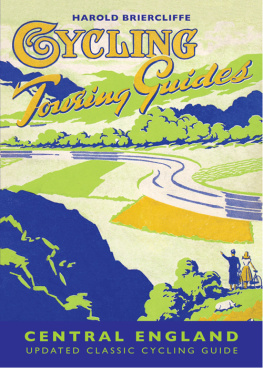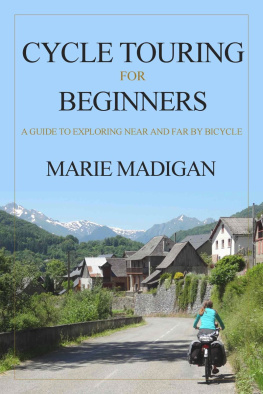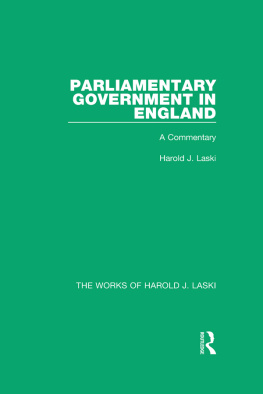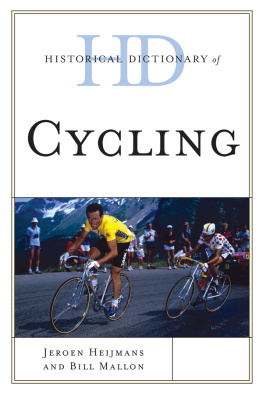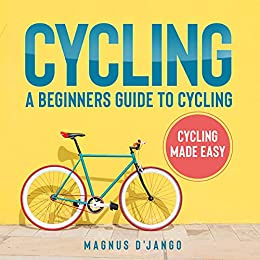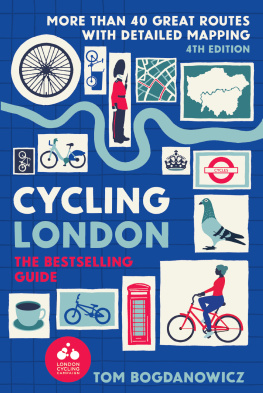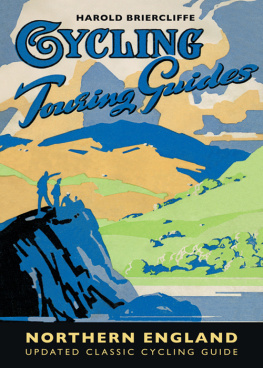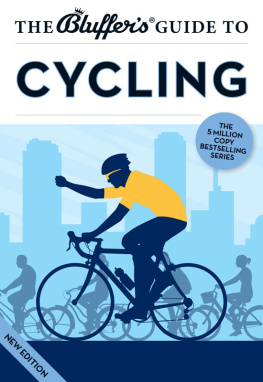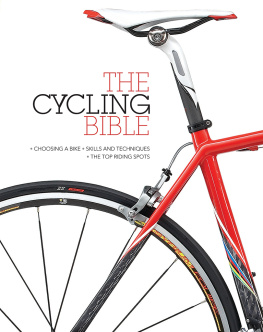Harold Briercliffe - Cycling Touring Guide : Central England
Here you can read online Harold Briercliffe - Cycling Touring Guide : Central England full text of the book (entire story) in english for free. Download pdf and epub, get meaning, cover and reviews about this ebook. year: 2012, publisher: Batsford, genre: Home and family. Description of the work, (preface) as well as reviews are available. Best literature library LitArk.com created for fans of good reading and offers a wide selection of genres:
Romance novel
Science fiction
Adventure
Detective
Science
History
Home and family
Prose
Art
Politics
Computer
Non-fiction
Religion
Business
Children
Humor
Choose a favorite category and find really read worthwhile books. Enjoy immersion in the world of imagination, feel the emotions of the characters or learn something new for yourself, make an fascinating discovery.
- Book:Cycling Touring Guide : Central England
- Author:
- Publisher:Batsford
- Genre:
- Year:2012
- Rating:3 / 5
- Favourites:Add to favourites
- Your mark:
- 60
- 1
- 2
- 3
- 4
- 5
Cycling Touring Guide : Central England: summary, description and annotation
We offer to read an annotation, description, summary or preface (depends on what the author of the book "Cycling Touring Guide : Central England" wrote himself). If you haven't found the necessary information about the book — write in the comments, we will try to find it.
Cycling Touring Guide : Central England — read online for free the complete book (whole text) full work
Below is the text of the book, divided by pages. System saving the place of the last page read, allows you to conveniently read the book "Cycling Touring Guide : Central England" online for free, without having to search again every time where you left off. Put a bookmark, and you can go to the page where you finished reading at any time.
Font size:
Interval:
Bookmark:


Thanks to Sam Howard at Sustrans for providing details of the latest Sustrans routes, and to Ruth Briercliffe for her assistance.
First Published 1949
(under the title Cycling Touring Guides: The Midlands)
Revised edition published 2012 by
Batsford
10 Southcombe Street
London W14 0RA
An imprint of Anova Books Company Ltd
Volume Batsford, 2012
First ebook publication 2012
Additions by Mark Jarman and Sustrans
The moral rights of the author have been asserted.
All rights reserved. No part of this publication may be reproduced, stored in a retrieval system, or transmitted in any form or by any means electronic, mechanical, photocopying, recording or otherwise, without the prior written permission of the copyright owner.
ebook ISBN: 9781849940641
A CIP catalogue record for this book is available from the British Library.
20 19 18 17 16 15 14 13 12
10 9 8 7 6 5 4 3 2 1
Also available in paperback ISBN-13: 9781849940405
Neither the publisher nor the author can accept responsibility for any changes, errors or omissions in this guide, or for any loss or injury incurred during the use of any of the cycling routes.
T he Britain by Bike TV series was based on a collection of old and largely forgotten cycling guides written by Harold Briercliffe over 60 years ago in the late 1940s. Such was the interest in the TV series and associated book that the guides quickly went from almost unknown on the second-hand market to much sought after and almost impossible to obtain. Perhaps the main reason for the renewed interest in the guides is that they take you back to a time many now see as cyclings golden era. They are so much more than slightly dated books with directions to help you find your way from A to B. Indeed anyone who sought out the original The Midlands guide in the belief that it would provide accurate and reliable information about the best cycle routes around Central England will be rather disappointed. Clearly, as a 21st-century cycling guide, Harold Briercliffes writings are no longer as helpful as they once were as so many aspects that impact upon cycling conditions have changed dramatically since the 1940s. For this reason, in this revised reissue the end of each chapter includes details of current recommended Sustrans routes that can be used to help explore the places that Briercliffe visited on his cycle journeys. The real joy of Harolds original books is their insight into Britain in an earlier age and a reminder of a gentler pace of life and the attractions of cycle touring around Britain.
The starting point for understanding and appreciating the guides is to look at the context in which they were written. In the post-war years, Harold Briercliffe was a writer for Cycling magazine, then the UKs main cycling publication. The guides were assembled from the feature articles written in the magazine, with each issue covering an area of the UK that later formed the basis of a chapter within the regional guides. The first guide was published in 1947 and covered the Northern England region. Over the next few years a further five were produced ending with the Southern England guide, which was published in 1950.
The post-war Britain that Briercliffe encountered on his cycling journeys was a place in the midst of austerity, where rationing strictly controlled the availability of essentials, including food, clothes and fuel. It is worth remembering that at the end of the 1940s only 1 in 7 households had access to a car. If you were one of the few that did have a car your familys vehicle was likely to have little in common with todays air-conditioned people carriers and 4 x 4s. The most popular cars of the day were rather uncomfortable and modestly sized by modern standards with the Morris Minor and the Austin A30 being two of the most popular 1950s models. For most people, the main methods of mechanised transportation were rail, bus and, of course, the bicycle. With the average workers holiday being only one or two weeks a year, the bicycle was seen as a key form of transport, offering cheap and easy access to the UKs places of interest (alongside bus and rail travel). During this period, the UKs cycling industry output was moving towards its peak. There were numerous manufacturers producing bicycles not only for the domestic market but for export all over the world. Notable companies from that era include Phillips, Dawes, BSA, Holdsworth, Royal Enfield, Elswick, Sunbeam, Evans, Claud Butler, Bates and Hetchins. But it was Raleigh that became established as the leading bicycle manufacturer of the day with the companys bicycle production reaching a peak of over a million in 1951. This increase in demand and supply was accompanied by advances in design so that bicycles became much more suited to longer distance touring. The use of lightweight 531 tubing to build the classic diamond-shaped frame (including randonneur handlebars), and the introduction of the simplex derailleur gear system and cantilever brakes, meant that the bicycles available in the early 1950s looked remarkably like modern touring bikes (although todays bicycles benefit from more sophisticated alloys of steel and aluminium as well as a much greater range of gears and better pedals).
For those who might have been slightly less enthusiastic about spending their leisure time on a bike, there was relatively little to encourage them to stay indoors. This was a world without games consoles, personal stereos, home computers or wide-screen TVs. By the beginning of the 1950s only 8% of households in the UK had a TV. For the few television owners, there was only one station (ITV did not join the BBC until 1955) and the broadcasting hours were very limited. So for the vast majority, the radio wireless provided the main source of family entertainment within the home. Cinema was the only other boom area for entertainment.
Against this background of ongoing rationing and limited forms of entertainment, it is perhaps easier to understand the reasons why Harold Briercliffe (approaching 40) embarked on the monumental task of covering the whole of the UK by bike. Following production of the Northern England guide in 1947, Briercliffes articles in Cycling magazine were gradually used to form a series of regional guides covering the Scottish Highlands, Wales, South West England, and The Midlands before finishing with Southern England.
The Midlands guide, which in this revised edition we have renamed Central England, covered an enormous area of the UK that went well beyond the confines of more standard definitions of that region. He defined it as starting at the northern edge of the Cotswolds and continuing as far north as the River Mersey. The western boundary of the region was rather imprecise but considered to be a rough line joining Chester, Hereford and Newport. And the eastern boundary of the region seemed to use the Great North Road linking Doncaster down towards Newark and Grantham, eventually joining Huntingdon and Ware before going all the way to the Thames at London Bridge. As Briercliffe accepted The Midlands then, for the purposes of this guide, constitutes a far-flung region.
Many parts of this central area of Britain have experienced significant changes over the last 60 years, particularly in terms of housing and traffic growth. Briercliffe suggests the use of what are now very busy A roads to cycle out of main urban areas. In the case of
Font size:
Interval:
Bookmark:
Similar books «Cycling Touring Guide : Central England»
Look at similar books to Cycling Touring Guide : Central England. We have selected literature similar in name and meaning in the hope of providing readers with more options to find new, interesting, not yet read works.
Discussion, reviews of the book Cycling Touring Guide : Central England and just readers' own opinions. Leave your comments, write what you think about the work, its meaning or the main characters. Specify what exactly you liked and what you didn't like, and why you think so.

